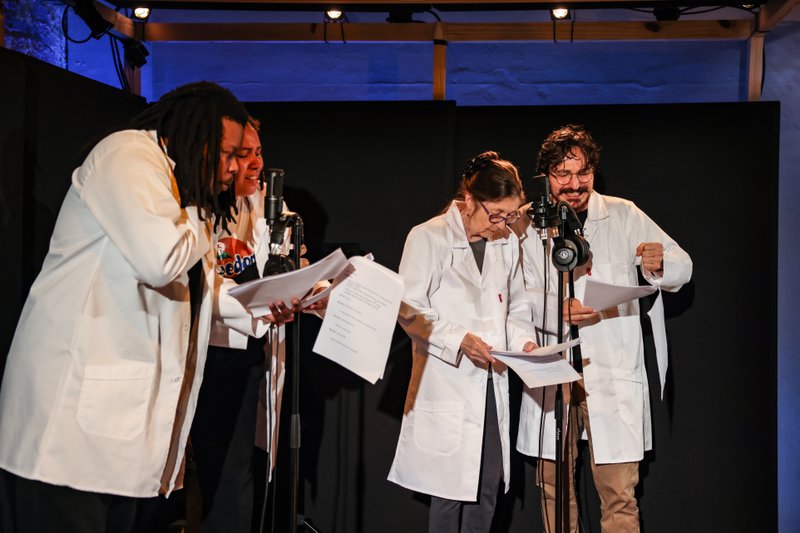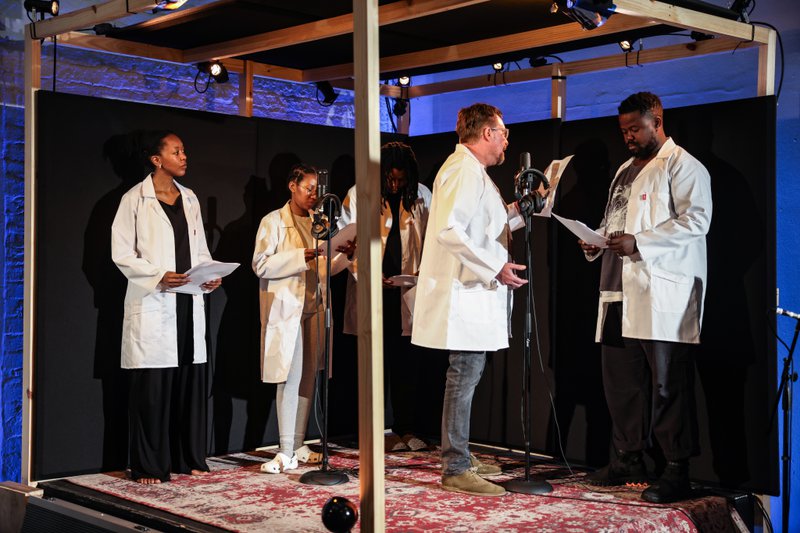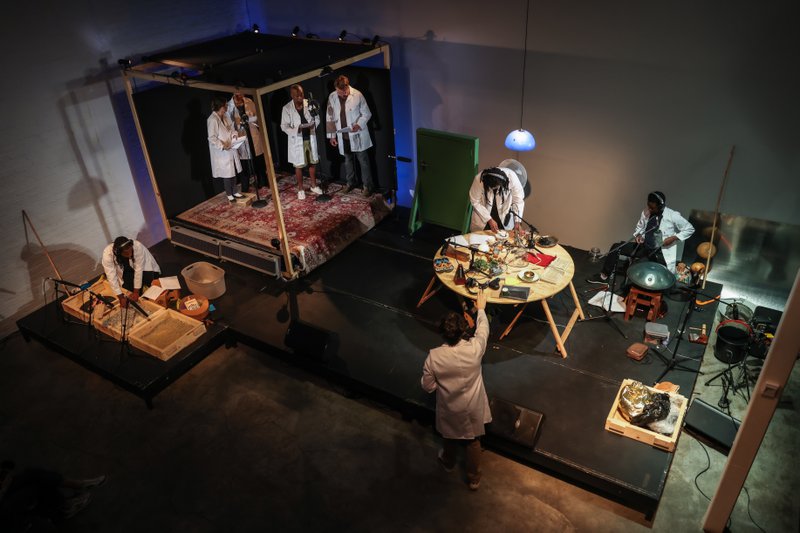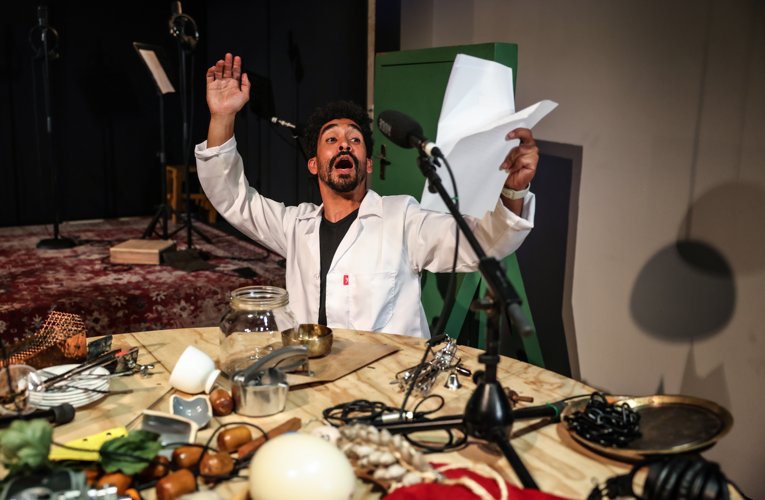William Kentridge and Wole Soyinka in dialogue on a Joburg night against backdrop of Windybrow teenagers depicting the reality of life in Hillbrow
By Edward Tsumele, CITYLIFE/ARTS Editor
There is no doubt that many a guest who converged at The Centre for Less Good Idea in Maboneng on Thursday last week were attracted by the idea of two of the continent’s intellectual giants, artists who enjoy international stature in their respective art practices.
South African creative William Kentridge who founded The Centre has distinguished himself over the years as a multi-disciplinary artist who is excellent in drawing, as he is in film and theatre, while his fellow discussant Nigerian born Professor Wole Soyinkwa represents everything that is great about Africa when it comes to the question of creativity.

An academic, poet, short story writer and novelist of immense talent, until in recent years, he was based for years in the UK where he taught at several universities, while writing intellectually stimulating plays, poetry and novels that speak of the human conditions in West Africa in general, and his native Nigeria in particular.
So clearly the two luminaries, who on the night engaged in a short but informative dialogue, facilitated superbly by an equally talented composer Neo Muyanga, who is The Centre For Less Good Idea’s new impresario, were the reason why many left the comfort of their northern suburbs homes. They did not think twice about the decision this time to head to a part of Johannesburg that sometimes makes one’s hair to stand and shake because of its reputation for crime.

However the crowd got more than what they had bargained for from unexpected quarters – teenagers from the inner city flatland of Hillbrow. The evening’s performances were in three parts. First we got to listen to a reading of excepts from one of Soyinka’s seminal works, a play informed very much by the Greek mythology, complete with blood-letting and tragedy, features that over the years, have defined the style of Greek theatre.
Though it was a simple reading, we were captured by the story simply because of the superb delivery by the cast that appeared to be acting on stage, rather than merely reading. I was especially touched by the performance by Muyanga, who interpreted the except through a classical rendition. Muyanga has demonstrated over the years that he is an artist who can easily switch from pop music into classical music (He is in fact classically trained).
But those of us, who had the privilege to watch Muyanga and fellow musician Masumbuko Chipembere from Malawi, as part of an extremely popular soul/pop duo called Black Sunshine at various venues around the country in the late 1990s and early 2000s, will remember how this duo defined a new unique sound that melded soul and pop sounds in a way that had not been done before.
I watched the group at Bassline, the iconic music venue that used to call the then vibrant 7th Street in Melville its home. Muyanga has now shifted musical gear and gone back into working in the classical music genre as a composer for orchestras, performer and conductor. On Thursday, he demonstrated that he is comfortable in that genre.
After the reading, the audience had time to listen to the wisdom given by Kentridge and Soyinka, who were asked short but interesting questions by Muyanga, such as what they had failed at as they grew up as they experimented in different individual endeavours.
After this short discussion, a short black and white film by Kentridge, a work in progress that is inspired by the late celebrated poet from the island of Martinique Cesaire when she went back to her country after years of being away from the country of her birth, was first screened to the public in the last season of The Centre’s artistic programme last year. It touched the audience then as it did on Thursday.
Little did we know that the screening of this short film was a precursor and in a way, the setting of the tone of what we were to witness from the Cesaire Youth –the teenagers from Windybrow Centre of the Arts in Hillbrow.

Their performance, which came in the form of partly a reading of text and partly acting, was awe inspiring as the teenagers read the text exuding much energy and seemed to be emotionally involved in the stories they were telling about their suburb, a place that even Angels fear to tread because of its notoriety for crime and grime. Hillbrow today is mainly a flatland, an overcrowded settlement of mainly African immigrants from all over the continent.
The text in this play, aptly titled Notebook of a Long Day’s Journey into a Hillbrow Night, is emotion gripping, painting a colourful picture of life in the streets of Hillbrow –the bad, the good and the ugly. The human condition of the suburb is well captured in well crafted prose and poetic stanzas.
Perhaps this should not surprise anyone because these Windybrow Teenagers, after school hours have found a home at Windybrow Centre of the Arts, where they polish their writing, acting and singing skills as part of their extra mural activities. Watching the energy with which they read the text, written in the main languages spoken in the suburb – isiZulu, French and English, the Windybrow Teenagers carried the audience right into the belly of this suburb that the wealthy today in South Africa avoid at all costs.
One could at times be filled with fear as one listened to the tales in this play, almost as if one was right in the belly of this famous but much feared place in contemporary South Africa. But through this production, delivered in hearty singing and raw dialogue, one at the same time was made to realize that the issue of crime, prostitution, public drinking, drunken behavior and violence that constantly stalk this suburb, are a daily experience for those who live there.
But like other people who embrace their neighbourhoods, The Windybrow Teenagers also equally embrace theirs, with all its bad, good and ugliness. To them Hillbrow is home and they are proud of it. The message was clear, and thanks to the powerful text and the energetic acting that almost seemed like it came naturally for the Windybrow Teenagers.
In this specific text the literary signatures of Stacy Hardy, one of the best prose writers and creative writing teachers in South Africa, who I had the benefit to be taught by on the MA in Creative Writing programme at Rhodes University during the 2022 session of the two year long course, and legendary poet Lesego Rampolokeng, also a former Rhodes creative writing lecturer, are all over the pages on which the text is written. Hardy is now head of the Creative Writing programme at Wits, while Rampolokeng is back in the trenches, once again performing his material.
The two literary luminaries worked alongside Nhlanhla Mahlangu, Sibahle Mangena, Khethukuthula Jele, Tamara Guhrs and Pule ka Janolintji as mentors band directors of the Windybrow Teenagers.
When the cast finished their performance, the audience rightly gave them a standing ovation, and for a moment, that moment, we even forgot that the scene that had just been depicted is about an area of Johannesburg we fear so much, and avoid passing through at all costs. That is the power of art, touching the audience’s emotional nerve.
Notebook of a Long Day’s Journey into a Hillbrow Night, was created by Winduybrow Centre of the Arts, and the Wits Creative Writing Programme, with support from The Neubauer Collegium for Culture and Society at the University of Chicago, Institut Francais d’Afrique du Sud and The Centre for Less Good idea.
However these festivities on Thursday were part of a bigger programme of a new season conceptualised by Muyanga at The Centre.
The festivities ran From 4 to 6 April 2024, hosting the first iteration of Collations, that invited a gathering of writers and performers in the realms of theatre to explore and expand upon the medium of the radio play by staging a series of Visual Radio Plays for a live audience.
Central to this exploration is the invitation to Nigerian playwright, novelist, poet, and essayist Soyinka who engaged in The Centre’s processes. In addition to the live programme of Visual Radio Plays, there was also the HOW | Showing the Making led by Neo Muyanga, and an In Conversation featuring Muyanga, Soyinka, and William Kentridge.
Following The Centre’s key methodologies of collaborative making, free-spirited engagement with materials, and allowing oneself to be led by image, sound and impulse, this series of original short-form radio plays was mounted for the stage, using live foley and performance.

Conceptualised and led by Muyanga, On Air: Visual Radio Plays form part of the first iteration of Collations – a short, focussed series of performance-based events around a central theme, method or point of interest. A second iteration of Collations is planned to take place in October 2024, inviting new filmmakers into the process and extending the exploration to the medium of silent films.
For Muyanga, who joined as The Centre’s Impresario in November 2023, the project has two key points of exploration, namely, a dramaturgy of sound, and a contemporary aurality.
“I’m interested in discovering what happens when sound becomes the driving force for what’s on stage,” explains Muyanga. “The other point of interest is the idea of orality or aurality having been described by many theorists as the way that the pre-colonial psyche received information, versus the contemporary post-colonial condition where we take in a lot of our information, visually. So, I’m interested in juxtaposing those two senses and seeing what’s revealed.”
Among the artists and writers who were invited into the Visual Radio Plays project are award-winning poet and performer Koleka Putuma, acclaimed theatremaker Andrew Buckland, theatre-maker and performance artist Qondiswa James, and writer and researcher Stacy Hardy.
Following an initial reference gathering in January 2024, each of the writers drafted their scripts. A five-day workshop in March then saw the scripts finding their way onto the stage, and being developed into live performances.
Two separate programmes of Visual Radio Plays was staged. On Friday 5 April, The Dalmatian and the Duck, World-Class African Citizens, and A Tempest (for the sea under the city) was performed, while Saturday 6 April saw Chosi Instomi!, And Then the Sea, and eMalahleni being staged.
This night was in fact one of the few to remember under the Johannesburg skyline.










